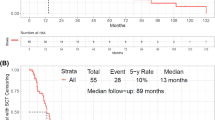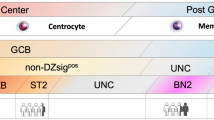Abstract
The Philadelphia (Ph) chromosome with a BCR/ABL fusion gene is a characteristic feature of chronic myeloid leukemia (CML) and partial acute lymphoblastic leukemia (ALL) patients, with different breakpoints of the BCR and ABL genes. Here, we report the case of a Ph-positive ALL patient with poor prognosis in whom simultaneous different BCR/ABL transcripts named e1a3, e1a4, and e1a5 were detected by RNA-seq analysis but not traditional RT-PCR. To our knowledge, this is the first report to describe coexistence of different atypical BCR–ABL transcripts in the same patient and that traditional TKI therapy may not overcome the poor prognosis. This finding will bring new challenges in diagnosis and monitoring for minimal residual disease.


Similar content being viewed by others
References
Baccarani M, Rosti G, Soverini S. Chronic myeloid leukemia: the concepts of resistance and persistence and the relationship with the BCR-ABL1 transcript type. Leukemia. 2019;33:2358–64.
Chen L, Wu Y, You Y, Xiao M, Yao Y, Li W. A novel e8a2 BCR-ABL1 intronic fusion through insertion of a chromosome 22 BCR gene fragment into chromosome 9 in an atypical Philadelphia (Ph) chromosome chronic myeloid leukemia patient. Leuk Lymphoma. 2016;57:2930–3.
Chisti MM, Sanders DS. Chronic myeloid leukemia with b3a3 (e14a3) fusion: a rare BCR/ABL rearrangement presenting with thrombocytosis—does MTHFR polymorphism matter. Case Rep Oncol. 2018;11:485–92.
Duan MH, Li H, Cai H. A rare e13a3 (b2a3) BCR-ABL1 fusion transcript with normal karyotype in chronic myeloid leukemia: the challenges in diagnosis and monitoring minimal residual disease (MRD). Leuk Res. 2017;59:8–11.
Kearney L, Crampe M, Langabeer SE. Frequency and spectrum of atypical BCR-ABL1 transcripts in chronic myeloid leukemia. Exp Oncol. 2020;42:78–9.
Kim J, Park TS, Lyu CJ, Song J, Lee KA, Kim SJ, et al. BCR/ABL rearrangement with b3a3 fusion transcript in a case of childhood acute lymphoblastic leukemia. Cancer Genet Cytogenet. 2009;189:132–7.
Liu B, Zhang W, Ma H. Complete cytogenetic response to Nilotinib in a chronic myeloid leukemia case with a rare e13a3(b2a3) BCR-ABL fusion transcript: a case report. Mol Med Rep. 2016;13:2635–8.
Martinez-Serra J, Del Campo R, Gutierrez A, Luis Antich J, Ginard M, Duran MA, et al. Chronic myeloid leukemia with an e1a3 BCR-ABL fusion protein: transformation to lymphoid blast crisis. Biomark Res. 2014;2:14.
Yan Z, Shanmugasundaram K, Ma D, Luo J, Luo S, Rao H. The N-terminal domain of the non-receptor tyrosine kinase ABL confers protein instability and suppresses tumorigenesis. J Biol Chem. 2020;295:9069–75.
Author information
Authors and Affiliations
Corresponding author
Ethics declarations
Conflict of interest
The authors declare that they have no conflict of interest.
Additional information
Publisher's Note
Springer Nature remains neutral with regard to jurisdictional claims in published maps and institutional affiliations.
About this article
Cite this article
Sun, H., Yan, Z. & Zhang, S. Three atypical BCR/ABL transcripts detected simultaneously in a Philadelphia-positive acute lymphoblastic leukemia patient showing resistance to tyrosine kinase inhibitors. Int J Hematol 117, 134–136 (2023). https://doi.org/10.1007/s12185-022-03451-4
Received:
Revised:
Accepted:
Published:
Issue Date:
DOI: https://doi.org/10.1007/s12185-022-03451-4




